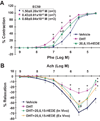Androgen-dependent hypertension is mediated by 20-hydroxy-5,8,11,14-eicosatetraenoic acid-induced vascular dysfunction: role of inhibitor of kappaB Kinase
- PMID: 21321301
- PMCID: PMC3074296
- DOI: 10.1161/HYPERTENSIONAHA.110.161570
Androgen-dependent hypertension is mediated by 20-hydroxy-5,8,11,14-eicosatetraenoic acid-induced vascular dysfunction: role of inhibitor of kappaB Kinase
Abstract
Increased vascular synthesis of 20-hydroxy-5,8,11,14-eicosatetraenoic acid (20-HETE) is associated with increased vascular contraction, endothelial dysfunction, and endothelial activation; all are believed to account for 20-HETE prohypertensive properties. We demonstrated previously that the 20-HETE-dependent inhibition of NO production is mediated through inhibitor of κB kinase (IKK), suggesting a cross-talk between 20-HETE-mediated endothelial dysfunction and activation. In this study, we examined the temporal relationship among blood pressure, endothelial dysfunction, and endothelial activation and the role of IKK in the rat model of androgen-driven 20-HETE-mediated hypertension. In Sprague-Dawley rats treated with 5α-dihydrotestosterone, renal vascular 20-HETE levels increased by day 2 of treatment from 17.7±2.4 to 57.7±9.7 ng/mg, whereas blood pressure elevation reached significance by day 3 (132.7±1.7 versus 117.2±0.8 mm Hg). In renal interlobar arteries, when compared with vehicle, 5α-dihydrotestosterone treatment increased the sensitivity to phenylephrine-induced vasoconstriction by 3.5-fold, decreased acetylcholine-induced vasorelaxation, and increased nuclear factor κB activity, all of which were attenuated by treatment with the 20-HETE antagonist, 20 hydroxyeicosa-6(Z),15(Z)-dienoic acid, (20-6,15-HEDE). Cotreatment with parthenolide, an IKK inhibitor, attenuated the androgen-dependent 20-HETE-mediated elevation in blood pressure (from 133.7±3.1 to 109.8±3.0 mm Hg). In addition, parthenolide treatment negated 20-HETE-mediated inhibition of the relaxing response to acetylcholine and 20-HETE-mediated increase in vascular nuclear factor κB activity. These findings suggest that inhibition of IKK attenuates the androgen-dependent 20-HETE-mediated increase in blood pressure by inhibiting both 20-HETE-dependent endothelial activation and dysfunction.
Figures





Comment in
-
Androgens and hypertension: role in both males and females?Hypertension. 2011 Apr;57(4):681-2. doi: 10.1161/HYPERTENSIONAHA.110.162750. Epub 2011 Feb 14. Hypertension. 2011. PMID: 21321304 Free PMC article. No abstract available.
Similar articles
-
20-hydroxy-5,8,11,14-eicosatetraenoic acid mediates endothelial dysfunction via IkappaB kinase-dependent endothelial nitric-oxide synthase uncoupling.J Pharmacol Exp Ther. 2010 Jan;332(1):57-65. doi: 10.1124/jpet.109.159863. Epub 2009 Oct 19. J Pharmacol Exp Ther. 2010. PMID: 19841472 Free PMC article.
-
20-HETE induces remodeling of renal resistance arteries independent of blood pressure elevation in hypertension.Am J Physiol Renal Physiol. 2013 Sep 1;305(5):F753-63. doi: 10.1152/ajprenal.00292.2013. Epub 2013 Jul 3. Am J Physiol Renal Physiol. 2013. PMID: 23825080 Free PMC article.
-
Vascular cytochrome P450 4A expression and 20-hydroxyeicosatetraenoic acid synthesis contribute to endothelial dysfunction in androgen-induced hypertension.Hypertension. 2007 Jul;50(1):123-9. doi: 10.1161/HYPERTENSIONAHA.107.089599. Epub 2007 Jun 4. Hypertension. 2007. PMID: 17548721
-
The role of 20-HETE in androgen-mediated hypertension.Prostaglandins Other Lipid Mediat. 2011 Nov;96(1-4):45-53. doi: 10.1016/j.prostaglandins.2011.06.006. Epub 2011 Jun 22. Prostaglandins Other Lipid Mediat. 2011. PMID: 21722750 Free PMC article. Review.
-
Role of the CYP4A/20-HETE pathway in vascular dysfunction of the Dahl salt-sensitive rat.Clin Sci (Lond). 2013 Jun;124(12):695-700. doi: 10.1042/CS20120483. Clin Sci (Lond). 2013. PMID: 23438293 Free PMC article. Review.
Cited by
-
Berberine ameliorates chronic kidney injury caused by atherosclerotic renovascular disease through the suppression of NFκB signaling pathway in rats.PLoS One. 2013;8(3):e59794. doi: 10.1371/journal.pone.0059794. Epub 2013 Mar 26. PLoS One. 2013. PMID: 23555784 Free PMC article.
-
Elevated 20-HETE in metabolic syndrome regulates arterial stiffness and systolic hypertension via MMP12 activation.J Mol Cell Cardiol. 2018 Apr;117:88-99. doi: 10.1016/j.yjmcc.2018.02.005. Epub 2018 Feb 8. J Mol Cell Cardiol. 2018. PMID: 29428638 Free PMC article.
-
Insights on the NF-κB system in polycystic ovary syndrome, attractive therapeutic targets.Mol Cell Biochem. 2024 Mar;479(3):467-486. doi: 10.1007/s11010-023-04736-w. Epub 2023 Apr 25. Mol Cell Biochem. 2024. PMID: 37097332 Review.
-
Androgen-sensitive hypertension associates with upregulated vascular CYP4A12-20-HETE synthase.J Am Soc Nephrol. 2013 Jul;24(8):1288-96. doi: 10.1681/ASN.2012070714. Epub 2013 May 2. J Am Soc Nephrol. 2013. PMID: 23641057 Free PMC article.
-
20-HETE-induced mitochondrial superoxide production and inflammatory phenotype in vascular smooth muscle is prevented by glucose-6-phosphate dehydrogenase inhibition.Am J Physiol Heart Circ Physiol. 2016 May 1;310(9):H1107-17. doi: 10.1152/ajpheart.00961.2015. Epub 2016 Feb 26. Am J Physiol Heart Circ Physiol. 2016. PMID: 26921441 Free PMC article.
References
-
- Reckelhoff JF. Gender differences in the regulation of blood pressure. Hypertension. 2001;37:1199–1208. - PubMed
-
- Burt VL, Whelton P, Roccella EJ, Brown C, Cutler JA, Higgins M, Horan MJ, Labarthe D. Prevalence of hypertension in the US adult population. Results from the Third National Health and Nutrition Examination Survey, 1988–1991. Hypertension. 1995;25:305–313. - PubMed
-
- Coylewright M, Reckelhoff JF, Ouyang P. Menopause and hypertension: an age-old debate. Hypertension. 2008;5:952–959. - PubMed
-
- Liu PY, Death AK, Handelsman DJ. Androgens and cardiovascular disease. Endocrine reviews. 2003;24:313–340. - PubMed
-
- Kienitz T, Quinkler M. Testosterone and blood pressure regulation. Kidney & blood pressure research. 2008;31:71–79. - PubMed
Publication types
MeSH terms
Substances
Grants and funding
LinkOut - more resources
Full Text Sources
Medical

